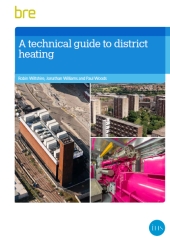A technical guide to district heating (FB 72)
BRE (Building Research Establishment) is an independent, research-based consultancy, testing and training organisation, operating in the built environment and associated industries.
On 2 December 2014, BRE published A technical guide to district heating (FB 72) by Robin Wiltshire, Jonathan Williams and Paul Woods.
District heating (DH) allows centralised heat sources to be connected to distributed heat consumers. Typically it comprises; one or more energy centres, the pipe network, and connections to consumers. The high heat loads compared to individual, independent systems allow economies of scale and smoother demand, leading to more efficient operation of the energy centre. It also allows the use of heat sources that would not be viable at a smaller scale.
FB 72 presents comprehensive information outlining system and component design, operation and maintenance. The 54 page guide is largely an update of Good Practice Guide 234, Guide to community heating and CHP, but it has been extended to emphasise the importance of other low-carbon sources of heat other than combined heat and power (CHP) including thermal renewable energy.
The guide focuses on technical rather than financial issues and will be useful for anyone involved in the technical aspects of district heating networks, whether on new or refurbishment schemes.
Its contents include:
- Executive summary.
- Introduction.
- What is district heating?
- System design.
- Component design.
- Operations and maintenance.
- References.
- Relevant standards, codes of practice and publications.
[edit] Find out more
[edit] Related articles on Designing Buildings Wiki
- BRE articles on Designing Buildings Wiki.
- BRE Buzz articles on Designing Buildings Wiki.
- BSRIA guide to heat interface units.
- Building Research Establishment.
- Combined heat and power.
- Community energy network.
- Geothermal energy.
- Heat interface units.
- Heat meter.
- Heat Networks Investment Project HNIP.
- Municipal energy - briefing sheet.
- National heat map.
- Water source heat map.
- What can government do about district heating.
Featured articles and news
One of the most impressive Victorian architects. Book review.
RTPI leader to become new CIOB Chief Executive Officer
Dr Victoria Hills MRTPI, FICE to take over after Caroline Gumble’s departure.
Social and affordable housing, a long term plan for delivery
The “Delivering a Decade of Renewal for Social and Affordable Housing” strategy sets out future path.
A change to adoptive architecture
Effects of global weather warming on architectural detailing, material choice and human interaction.
The proposed publicly owned and backed subsidiary of Homes England, to facilitate new homes.
How big is the problem and what can we do to mitigate the effects?
Overheating guidance and tools for building designers
A number of cool guides to help with the heat.
The UK's Modern Industrial Strategy: A 10 year plan
Previous consultation criticism, current key elements and general support with some persisting reservations.
Building Safety Regulator reforms
New roles, new staff and a new fast track service pave the way for a single construction regulator.
Architectural Technologist CPDs and Communications
CIAT CPD… and how you can do it!
Cooling centres and cool spaces
Managing extreme heat in cities by directing the public to places for heat stress relief and water sources.
Winter gardens: A brief history and warm variations
Extending the season with glass in different forms and terms.
Restoring Great Yarmouth's Winter Gardens
Transforming one of the least sustainable constructions imaginable.
Construction Skills Mission Board launch sector drive
Newly formed government and industry collaboration set strategy for recruiting an additional 100,000 construction workers a year.
New Architects Code comes into effect in September 2025
ARB Architects Code of Conduct and Practice available with ongoing consultation regarding guidance.
Welsh Skills Body (Medr) launches ambitious plan
The new skills body brings together funding and regulation of tertiary education and research for the devolved nation.
Paul Gandy FCIOB announced as next CIOB President
Former Tilbury Douglas CEO takes helm.
























